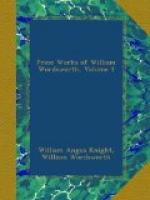The objections to white, as a colour, in large spots or masses in landscape, especially in a mountainous country, are insurmountable. In Nature, pure white is scarcely ever found but in small objects, such as flowers: or in those which are transitory, as the clouds, foam of rivers, and snow. Mr. Gilpin, who notices this, has also recorded the just remark of Mr. Locke, of N——, that white destroys the gradations of distance; and, therefore, an object of pure white can scarcely ever be managed with good effect in landscape-painting. Five or six white houses, scattered over a valley, by their obtrusiveness, dot the surface, and divide it into triangles, or other mathematical figures, haunting the eye, and disturbing that repose which might otherwise be perfect. I have seen a single white house materially impair the majesty of a mountain; cutting away, by a harsh separation, the whole of its base, below the point on which the house stood. Thus was the apparent size of the mountain reduced, not by the interposition of another object in a manner to call forth the imagination, which will give more than the eye loses; but what had been abstracted in this case was left visible; and the mountain appeared to take its beginning, or to rise, from the line of the house, instead of its own natural base. But, if I may express my own individual feeling, it is after sunset, at the coming on of twilight, that white objects are most to be complained of. The solemnity and quietness of Nature at that time are always marred, and often destroyed by them. When the ground is covered with snow, they are of course inoffensive; and in moonshine they are always pleasing—it is a tone of light with which they accord: and the dimness of the scene is enlivened by an object at once conspicuous and cheerful. I will conclude this subject with noticing, that the cold, slaty colour, which many persons, who have heard the white condemned, have adopted in its stead, must be disapproved of for the reason already given. The flaring yellow runs into the opposite extreme, and is still more censurable. Upon the whole, the safest colour, for general use, is something between a cream and a dust-colour, commonly called stone colour;—there are, among the Lakes, examples of this that need not be pointed out.[61]




